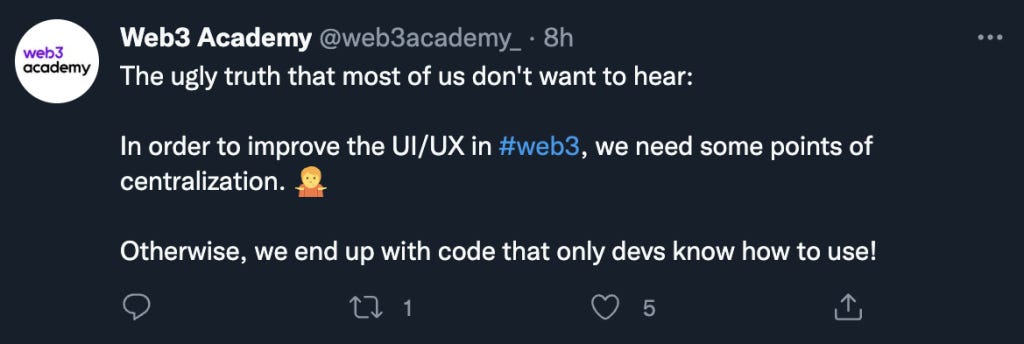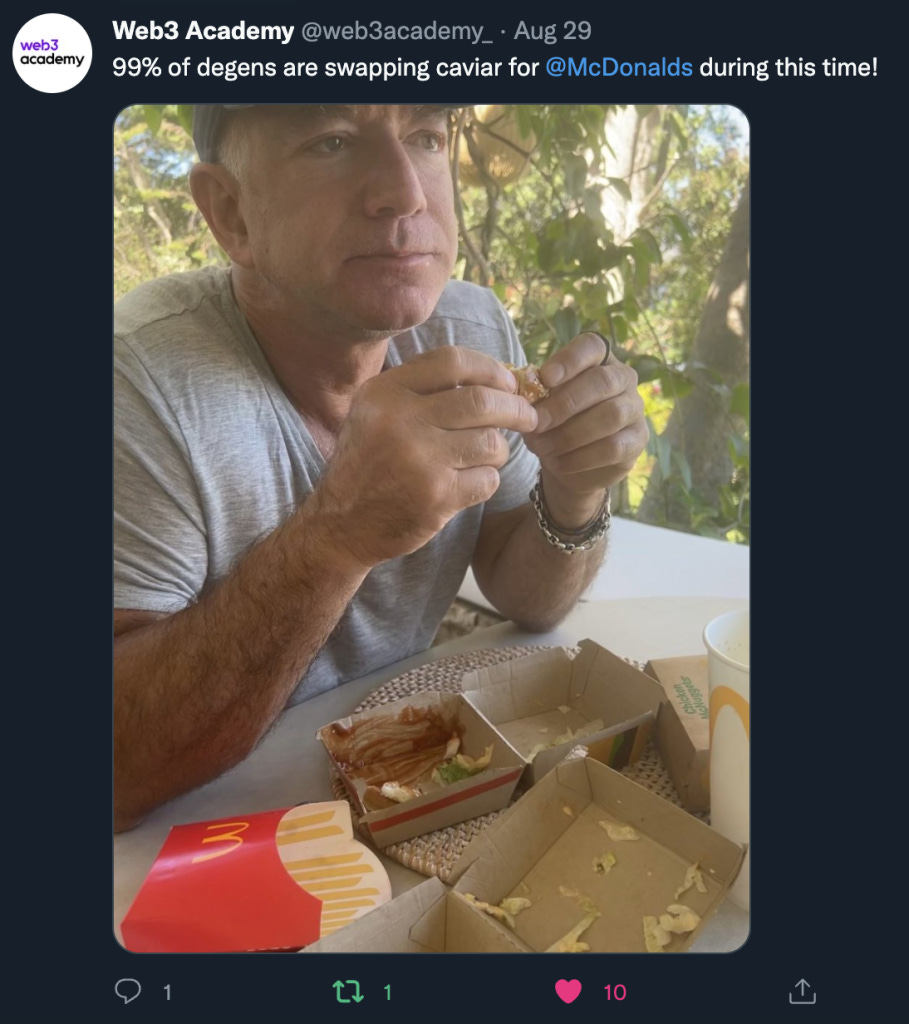Is Web3 Decentralized And Censorship Resistant? | Nader @ Developer DAO
Gm Web3 Academy DOers!
Web3 is supposed to be a fully decentralized and permissionless ecosystem where anybody, regardless of their geographical location, can participate.
However, recent events are suggesting otherwise. 🤷
The Tornado Cash front end has been shut down, one of the developers behind the protocol has been arrested and even Uniswap is banning hundreds of users.
But how is this possible? Aren’t these protocols supposed to be run on a fully decentralized and open sourced blockchain? 🤔
The answers to these questions are a bit more complicated than they seem. To tackle them, we’ve brought on Nader Dabit on our podcast! Nader is a developer at Celestia, Founder of Developer DAO and has formerly held a senior position at AWS.
Needless to say, Nader knows a thing or two about the state of decentralization / centralization in both Web2 and Web3.
Let’s dig into it! 🔥
Wait 🚥 Not into reading? 📖
Sit back and watch on Youtube 👀 or listen on Spotify or Apple Podcasts 🎧
Interested in working with some of the top crypto / web3 media companies?
We're hiring at Web3 Academy & ImpactDM. Here's our available roles
Copywriter & Content Writer - Click HERE for the job description 🚀
Lead Gen Specialist - Click HERE for the job description 🤩
Youtube Video Editor - Click HERE for the job description 👀
The State Of Decentralization In Web3
While the promise of Web3 is to be fully decentralized, the truth is that right now, most of Web3 is pretty centralized.
Most of the biggest actors in this space are crypto exchanges like Binance and Coinbase and VCs like Pantera Capital or a16z. All of which are centralized companies working with Web3 and crypto.
Now, you might ask yourself… What about the decentralized protocols like Uniswap or Aave?
Well, we need to get some things straight here before going any further.
Most of the big applications and protocols in Web3 are running on Ethereum, which is fully decentralized.
This means that all of the transactions and data that go through Ethereum, are safely stored in an open sourced protocol.
However, the actions that you take to interact with most of the protocols in Web3 are through a front end website, which is typically run on Amazon Web Services (AWS) or something similar.
AWS essentially provides cloud computing platforms and APIs, aka the ability for you to have your website live on the web. And all of what’s built upon AWS is stored in their own server farms, which they control.
In other words, AWS has the ability to shut anything off, at any given moment. And to keep in line with laws, AWS will shut off anything that regulators demand.
Now, although the front end website might get turned off (like what happened with Tornado Cash), the back end technology (which lies on the blockchain) is still operable. So, if you're a skilled enough developer, you can still use Tornado Cash today. It’s just that the front end website has been erased.
To conclude:
Front end (website) - centralized (can get shut off at any time)
Back end (blockchain) - decentralized (open sourced and permissionless)
🎉 Tweet Of The Week 🎉
Can Regulators Kill Decentralized Protocols?
The short answer is no! But it’s not as simple as you think…
Regulators can never shut off protocols like Ethereum or Bitcoin, no matter how hard they try.
These systems will always run by themselves, unless the internet collapses throughout the entire planet.
Protocols which are built on top of these blockchains can also be permissionless and free from regulators.
However, the tech that is used to host or interact with many of these protocols or applications are not as immune.
Most of them are registered LLC’s and have actual employees working full-time. This creates a vulnerability.
Let’s take Tornado Cash as an example again… Although the protocol is fully decentralized, the developer was still caught and the front end website was shut off.
Is the protocol still live? YES! But many can no longer easily use it.. This could definitely lead to the death of Tornado Cash, however there are ways to work around this.
The same could happen for Uniswap, who is a registered business in the US. What if regulators ask the team to ban all of the US users that go on the website?
Uniswap would need to blacklist US users from using the front end website of Uniswap which interacts with Uniswap the protocol.
The protocol would still be live and well, however this would cut off the bulk of Uniswap’s user base.
I am not saying that this will happen, but it could. Especially with smaller protocols that are just getting started.
Do We Need To Decentralize Everything In Web3?
If we want regulators to fully stay outside of our way, then YES, we need to decentralize everything, even the front end websites and cloud storage
However, the problem with this is that a fully decentralized protocol would be a pain in the butt to use in terms of user experience (UX). 🤮 …at least right now.
If we want to grow as an industry, we must be fully focused on the UX. That’s what will onboard millions of users.
So, if we’re thinking about this from a long term perspective, we shouldn’t decentralize everything from the beginning.
The protocols which will move a lot of value or agitate regulators the most (like Tornado Cash) should focus on decentralization across the entire tech stack.
However, other protocols and apps like games, NFTs, social networks, etc. should simply do their best to stay under the radar of regulators and fully focus on the UX of their products and services.
Once we get that right, we can slowly decentralize parts of a protocol / application in order to remain permissionless and censorship resistant long into the future. .
To end this chapter, I must say that everything does not NEED to be decentralized, but it’s good to have that option available.
Let’s see which tools we can use to achieve that. 👇
What Tools Can We Use to Make The Tech Stack Decentralized In Web3?
On the podcast, we’ve asked Nader to highlight a few services that are helping us decentralize the space bit by bit…
Arweave - Allows anybody to create a HTTPS website (front end) that’s stored on a blockchain and cannot be taken down. Also lets you store bigger files such as videos or images on the blockchain.
Radicle - Allows you to create open sourced code that cannot be interfered with.
Graph Protocol - Allows you to store data on the blockchain safely and cheaply.
Livepeer - Building the world’s open and decentralized video infrastructure.
Of course, let’s not forget about Lens Protocol too, who are trying to decentralize the world of social media.
These are only a few protocols and apps that Nader highlighted on the podcast, which you can watch on YouTube, Spotify and Apple Podcasts. Make sure to give us a follow / subscribe!
😂 Meme Of The Week 😂
What’s Next For Web3?
Web3 is still super, super small. While regulation seems to be cracking down on us, we must keep in mind that there’s good regulation out there too that seeks to support innovation.
Find out more about the 👉 The State of Regulation In Crypto and Web3 in 2022 👈
Not every web3 project is targeted by laws and regulations so we need to relax a little bit.
The next steps for everybody that contributes in Web3 should be to double down on the UI and UX of their products and services.
Interacting with dApps today is a bit of a pain. You must have a Web3 wallet, you must understand certain things and you need to be quite tech savvy to interact with web3 today.
If we want our moms and dads to join this space, we must definitely make the interaction feel seamless and enjoyable.
Thanks for reading, frens ✌️
Before you go, tell us... Does everything need to be decentralized in Web3? Reply to this email with Yes or No
Connect with Nader on Twitter
🚀 Action Steps For Web3 DOers 🚀
👉 Does everything need to be decentralized in Web3? Reply to this email with Yes or No
👉 Check out Developer DAO and follow them on Twitter. They're a community of people that onboards developers into web3. 🔥
👉 Do you want to work with Web3 / Crypto clients? We've got 3 job opportunities for you:
👉 If you'd like to know more about regulation in web3 and crypto, refer to our 'The State of Regulation In Crypto and Web3 in 2022' article








